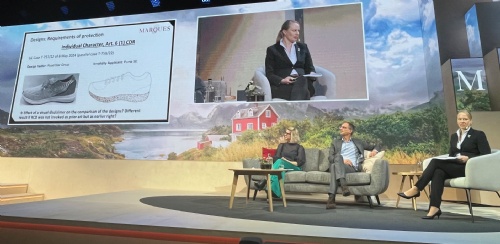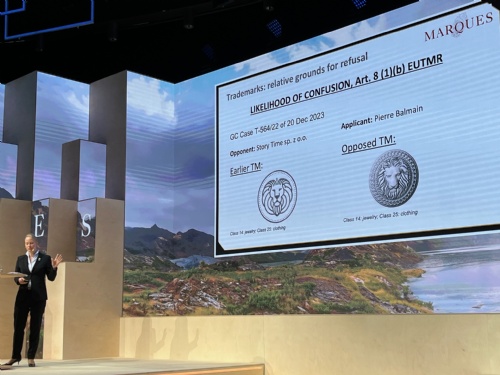CLASS 46
Now in its twelfth year, Class 46 is dedicated to European trade mark law and practice. This weblog is written by a team of enthusiasts who want to spread the word and share their thoughts with others.
Want to receive Class 46 by email?
Click here subscribe for free.
Click here subscribe for free.
Who we all are...
FRIDAY, 27 SEPTEMBER 2024
Annual Conference 2024, Stockholm – part 8
Tags: Annual Conference, Stockholm,


 Sharing on Social Media? Use the link below...
Sharing on Social Media? Use the link below...
Perm-A-Link: https://www.marques.org/blogs/class46?XID=BHA5298
Annual Conference 2024, Stockholm – part 8
 |
| Lauren Keller, Maarten Haak and Inga George |
In the final session of this year's MARQUES Annual Conference, “You can learn about the latest CJEU case law,” three practitioners discussed CJEU and General Court case law from the past year.
Lauren Keller, Jacobacci Avvocati, Italy, Co-Chair of the MARQUES Intellectual Asset Management Team, reviewed decisions on absolute grounds for refusal:
- Case T-320/23 NOT MILK: the Court noted that consumers are increasingly inclined to examine food packaging for health or dietary reasons and agreed with EUIPO that the mark applied for was descriptive for goods in classes 29 and 32. The graphical elements of the mark did not save the application.
- Case T-107/23 MYBACON: the mark applied for was found to be deceptive under Article 7(1)(g) for “fungi-based meat substitutes; meat substitutes” in class 29. The Court noted that the relevant consumers would purchase the goods in haste and put little cognitive effort into their purchase.
- Case T-274/23 ACAPULCO: The Court found that most people recognised Acapulco as a tourist destination and the mark applied for was descriptive for services in classes 41 and 44.
- Case T-747/22 Compton: Reversing a Board of Appeal decision concerning an application for goods in classes 18 and 25, the Court made a distinction between streetwear and conventional clothing and said the relevant public was the German public as whole, which did not know where the city of Compton is.
- Case T-597/22 Sophienwald: This case concerned an application to register a historical place name for goods in classes 14 and 21. The Court upheld the decision to refuse it. The graphical elements in the mark applied for were not sufficient to overcome the objection.
- Case T-255/23 PABLO ESCOBAR: The applicant applied for a mark in a wide range of goods and services and the Court upheld the decision to refuse it for being against public policy/accepted principles of morality. It said a large part of the Spanish public would associate the name Pablo Escobar with criminality, even though he was never convicted of a crime.
- Case T-19/22 Piaggio: The Court overturned a Board of Appeal decision, and found that the shape of the Vespa scooter had acquired distinctive character throughout the EU. The applicant had submitted a survey covering 83% of the EU as well as other evidence about the iconic status of the Vespa. “The case is a milestone as it shows it is possible to meet the Kit Kat criteria,” said Lauren.
- T-652/22 Veuve Clicquot orange: In this case, Lidl challenged the validity of Veuve Clicquot’s EU trade mark for the colour orange for champagne. Distinguishing between primary and secondary evidence, the Court annulled the Board of Appeal decision and remitted the case to the Board of Appeal – a decision is expected next year.
- Cases T-297/22 and T-298/22 Lego mini figures: The Court upheld the validity of the marks saying they did not consist entirely of the nature of the goods and the shape was not necessary for technical result. “We’re seeing more recognition of the registrability of 3D shapes as trade marks,” said Lauren.
 |
| Inga George illustrates the lion's head case |
Inga George, boesling IP, Germany, Co-Chair of the MARQUES Designs Team, chaired the panel and discussed cases on relative grounds for refusal:
- Case T-773/22: This concerned an EUTM application for the representation of a dachshund dog with the words GILBERT TECKEL and an earlier mark representing a dachsund which was registered for identical goods. The Court upheld a finding of likelihood of confusion. Inga said the case raised some questions but is “perfectly in line with previous CJEU case law”.
- Case T-564/22: The Court reversed a finding of likelihood of confusion between an EU trade mark application and an earlier mark which both comprised representations of a lion’s head. It said the similarities between the signs were not sufficient for a finding of likelihood of confusion even for identical goods. The panel speculated about whether some animals are more distinctive than others.
- Case T-157/23 Joy v Joyful by nature: The applicant for an EUTM for Joyful by nature argued that the earlier mark Joy for perfume had lost its reputation. But the Board held that some reputation survived, and the Court agreed. “This is positive news for owners of well-known trade marks and makes sense from a practical point-of-view,” said Inga.
- Case C-801/21 BASMATI: This Brexit-related case addressed the relevant point in time for the legal assessment. The General Court had said the Board of Appeal must make a decision based on the situation at the time of its first decision (ie before the end of the Brexit transition period). Rejecting an appeal by EUIPO, the CJEU upheld the General Court’s judgment. Comments from the audience criticised the ruling but also noted its limitations.
- Cases T-222/21 and T-281/21 Shoppi and APE TEES: These two cases, which are pending before the CJEU, raise similar issues to BASMATI but the relevant dates and timings are different.
 |
| MARQUES Chair Antony Douglass thanked everyone involved in this year's Annual Conference and looked forward to the 39th Annual Conference in The Hague (16-19 September 2025) |
Maarten Haak, Hoogenraad & Haak, Netherlands, a member of the MARQUES Unfair Competition Team, focused on CJEU preliminary rulings:
- Case C-361/22 Inditex v Buongiorno: The case concerned referential use of the ZARA mark. The Court repeated its existing case law in BMW v Deenik but did not elaborate further. “We will see more cases on referential use because it is not clear what is and is not allowed,” said Maarten.
- Case C-33/22 Audi v GQ: This case concerned a trade mark for the Audi grill. The Court distinguished between trade mark and design law but did not address the functions of the mark or referential use. The case will be assessed as normal trade mark infringement.
- Case C-367/21 Hewlett Packard v Senetic: In this case, the Court said that if the defendant faces insurmountable difficulties in proving the source of infringing goods, it is up to the trade mark owner to provide relevant information. If it does not, the burden of proof must be modified. “I expect this will slowly move towards getting more lenient toward resellers,” said Maarten.
- Case T-777/22 PLAN B: This raised the question whether it was bad faith to make an EUTM application while a case concerning an identical Spanish mark was pending. An appeal has been filed to the CJEU.
The panel also discussed some design cases; these will be reported on the Class 99 blog shortly.
Posted by: Blog Administrator @ 15.35Tags: Annual Conference, Stockholm,


 Sharing on Social Media? Use the link below...
Sharing on Social Media? Use the link below...Perm-A-Link: https://www.marques.org/blogs/class46?XID=BHA5298
Reader Comments: 0
Post a Comment
MARQUES does not guarantee the accuracy of the information in this blog. The views are those of the individual contributors and do not necessarily reflect those of MARQUES. Seek professional advice before action on any information included here.
The Class 46 Archive

